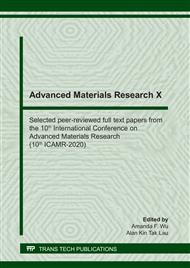[1]
Keskin, Y., H.S. Halkacı, and M. Kizil, An experimental study for determination of the effects of machining parameters on surface roughness in electrical discharge machining (EDM). The international journal of advanced manufacturing technology, 2006. 28(11-12): pp.1118-1121.
DOI: 10.1007/s00170-004-2478-8
Google Scholar
[2]
Sivakumar, K. and R. Gandhinathan, Establishing optimum process parameters for machining titanium alloys (Ti6Al4V) in spark electric discharge machining. International Journal of Engineering and Advanced Technology (IJEAT), 2013. 2: pp.201-204.
Google Scholar
[3]
Mohan, B., A. Rajadurai, and K. Satyanarayana, Effect of SiC and rotation of electrode on electric discharge machining of Al–SiC composite. Journal of Materials Processing Technology, 2002. 124(3): pp.297-304.
DOI: 10.1016/s0924-0136(02)00202-9
Google Scholar
[4]
Gaikwad, V. and V.S. Jatti, Optimization of material removal rate during electrical discharge machining of cryo-treated NiTi alloys using Taguchi's method. Journal of King Saud University-Engineering Sciences, 2018. 30(3): pp.266-272.
DOI: 10.1016/j.jksues.2016.04.003
Google Scholar
[5]
Muthuraman, V. and R. Ramakrishnan, Multi parametric optimization of WC-Co composites using desirability approach. Procedia engineering, 2012. 38: pp.3381-3390.
DOI: 10.1016/j.proeng.2012.06.391
Google Scholar
[6]
Singh, S., S. Maheshwari, and P. Pandey, Some investigations into the electric discharge machining of hardened tool steel using different electrode materials. Journal of materials processing technology, 2004. 149(1-3): pp.272-277.
DOI: 10.1016/j.jmatprotec.2003.11.046
Google Scholar
[7]
Hoang, T.T., et al., Modelling Surface Finish in Electrical Discharge Machining Tablet Shape Punches using Response Surface Methodology.
DOI: 10.17265/2162-5263/2017.07.006
Google Scholar
[8]
Hasçalık, A. and U. Çaydaş, Electrical discharge machining of titanium alloy (Ti–6Al–4V). Applied surface science, 2007. 253(22): pp.9007-9016.
DOI: 10.1016/j.apsusc.2007.05.031
Google Scholar
[9]
Amorim, F.L. and W.L. Weingaertner, The behavior of graphite and copper electrodes on the finish die-sinking electrical discharge machining (EDM) of AISI P20 tool steel. Journal of the Brazilian Society of Mechanical Sciences and Engineering, 2007. 29(4): pp.366-371.
DOI: 10.1590/s1678-58782007000400004
Google Scholar
[10]
Payal, H., R. Choudhary, and S. Singh, Analysis of electro discharge machined surfaces of EN-31 tool steel. (2008).
Google Scholar
[11]
Le Xuan Hung, T.T.H. and V.N. Pi, A Study on Modelling Surface Finish in Electrical Discharge Machining Tablet Shape Punches Using Response Surface Methodology.
DOI: 10.17265/2162-5263/2017.07.006
Google Scholar


